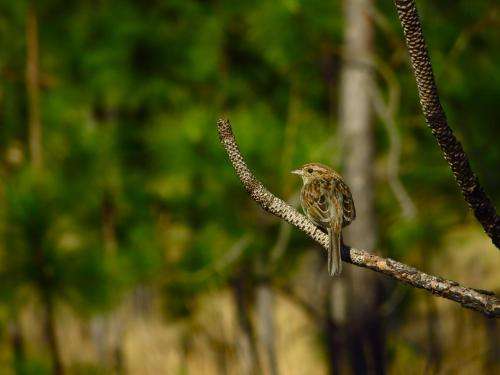Landscape-level habitat connectivity is key for species that depend on longleaf pine

Preserving isolated patches of habitat isn't enough to save species such as Bachman's Sparrow (Peucaea aestivalis) that depend on longleaf pine; habitat connectivity at the landscape level is also crucial. That is the message of a new paper by Paul Taillie, M. Nils Peterson, and Christopher Moorman of North Carolina State University, published this week in The Condor: Ornithological Applications.
In the past, fire-dependent longleaf pine forests covered vast, unbroken areas of the southeastern U.S., and Bachman's Sparrows and other species adapted to live in this expansive habitat. Today, however, longleaf pines exist primarily in isolated patches surrounded by agriculture and urban development. To see whether small but well-managed patches of longleaf pine were enough to support healthy Bachman's Sparrow populations, Taillie and his colleagues surveyed Bachman's Sparrows in 111 habitat patches in spring 2011 and tested what factors best explained their distribution. They found that while the sparrows did prefer patches that had been burned recently, an even stronger predictor of the presence or absence of Bachman's Sparrows was how much of the land within three kilometers was devoted to longleaf pine—that is, how connected a patch was to a larger longleaf pine landscape.
"While we know a lot about the local habitat characteristics affecting Bachman's Sparrow habitat selection, we don't know much about the role of landscape-level factors," explains Taillie. "As a result of this research, we found that habitat selection actually appears to depend on a very broad range of scales, from 100 meters to several kilometers. Other studies have shown similar patterns for other species associated with longleaf pine, which suggests that connectivity may be important to the function of the greater ecosystem, and possibly other highly fragmented ecosystems as well. Thus, conservation management and planning efforts, such as prescribed burning, habitat restoration, and land acquisition, should also consider a broad range of scales to benefit the diverse assemblage of organisms that comprise this community."
"Taillie, Peterson and Moorman have made a significant contribution to the understanding of Bachman's sparrow's use of the landscape in eastern North Carolina," adds Jeff Marcus of the Nature Conservancy, a longleaf pine management expert who was not involved in the research. "As the broader conservation community strives to restore and enhance longleaf pine habitat across its range, it is important to understand not only the habitat characteristics but also the landscape characteristics that will lead to the most robust and resilient outcome for longleaf-associated species. The Bachman's sparrow is an excellent indicator species to help inform longleaf pine habitat needs because it is closely tied to well-managed longleaf habitat."
More information: The relative importance of multiscale factors in the distribution of Bachman's Sparrow and the implications for ecosystem conservation is an open-access paper that can be viewed at www.aoucospubs.org/doi/full/10 … 1650/CONDOR-14-137.1
Provided by Central Ornithology Publication Office

















